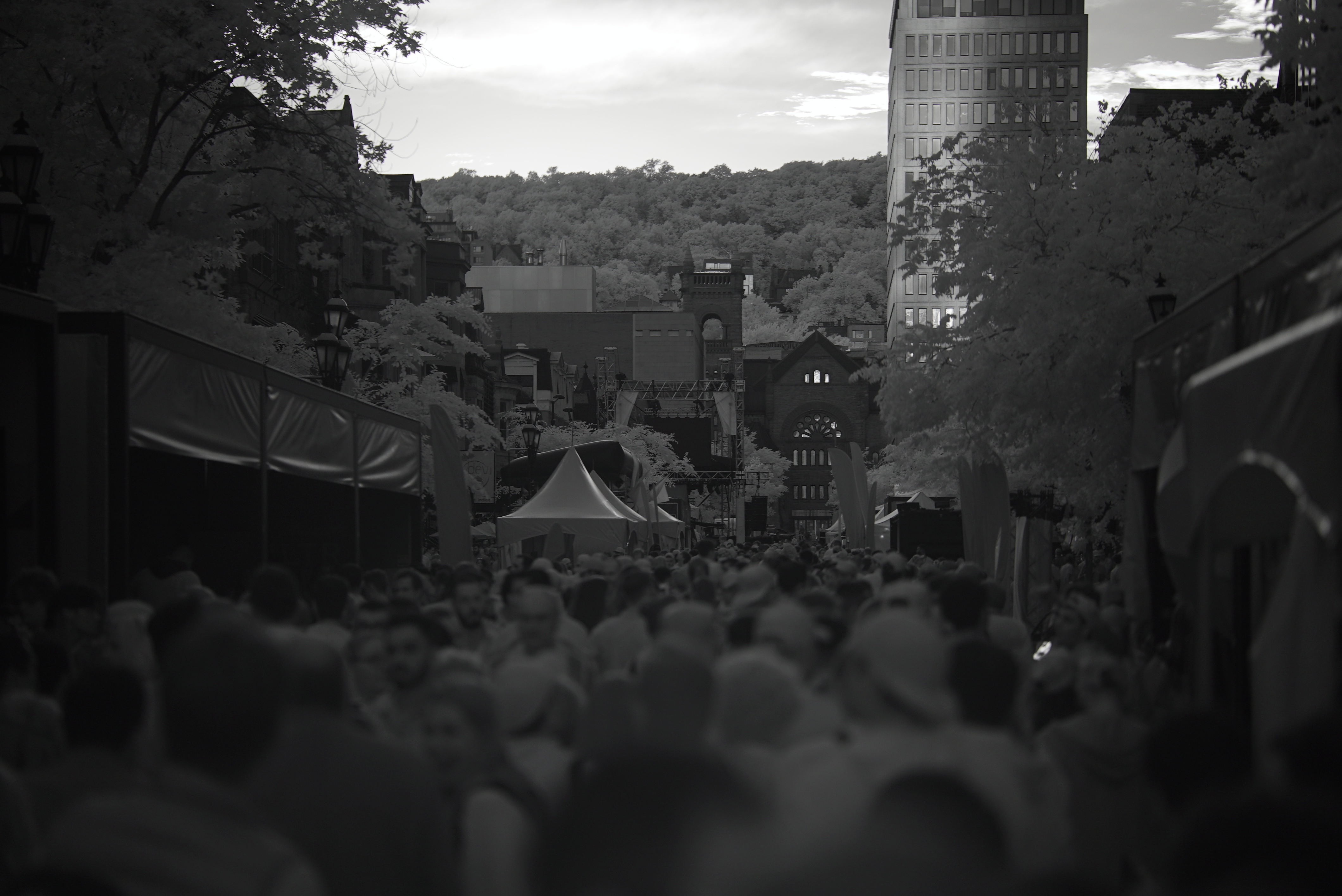
Several aspects of infrared photography particularly impact photos of people:
- Uniform colors
- Softened skin
- Cleaner backgrounds
- More flare and haze
Uniform Colors
Uniform ColorsUnder infrared, most clothing reflects an even bright tone. This makes it so that most of what everyoen is wearing appears in white (when shooting far infrared in black & white), or some shade of red when shooting with color. This unformity creates a look in street and fashion photos that lets one focus on the shape of a crowd, the form of an outfit, or the pose of the model rather than the colors and shades of the clothing and skin.
PHOTO HERE In this photograph, we see a group of people. The unfiformity of the colors in this shot contributes to a feeling of unity among the crowd. This can be used to accentuate the patterns of the people’s movements and social formations as an aggregate. This would be a fantastic way to shoot a crowded train station or a protest in black and white, making the crowds feel unified like a harmonious herd.
By breaking the
Softened Skin
Softened Skinphoto of sushi In this photo, we see how the various components of this sushi render the same under far infrared. This demonstrates the property of infrared photography that also helps even out skin texture and tone, creating especially flattering black & white head shots. slider comparing infrared and visible light and uv photo of my face Observe how in the infrared photo, the skin tone is even throughout, while preserving the texture of the skin so as to not look like a cheap skin softening filter. See how in the visible and infrared shots, the skin gets progressively more flawed. It seems the longer the wavelength of the light, the less flattering the shot is. This is intuitive — take the X-Ray as an extreme example of a photograph that reveals details under the skin.
Advanced technqiques with IR photography
Advanced technqiques with IR photographyNew Skin Smoothing Algorithm
New Skin Smoothing Algorithmslider comparing visible light to this technique. Maybe do this technique by taking a shot, then using some rig to quickly switch between IR bandpass and visible bandpass Imagine a camera that is able to capture an IR channel and a visible channel of light of a human face. Using frequency separation (link) and hue transfer (link), we can create a pipeline loosely as follows
- Segment out areas of skin in the visible channel
- Use frequenecy separation to get the hues of the skin in color
- (optional) Remove outlier hues (IE intense reds) from the skin, and use the luminance from the infrared channel
- Use the infrared channel as the high frequency component when reconstructing the skin This workflow would provide fully natural skin smoothing, without generative or distrotive effects. It may be “fake” but every detail of the skin as rendered would be physically present. This could result in skin smoothed photos with unbounded detail. A possible future camera with a 4 channel bayer sensor — R G B IR would enable this to be done in one-shot, and such a technique could generate a large dataset for an ML model designed for natural looking skin smoothing. example diagram of R G B IR bayer pattern
Compositional Aid
Compositional Aid** exmaple image of IR / vis composition** The IR channel distinctively unifies tones among subjects. A crowd shot in infrared looks uniform and cohesive, while in visible light the colors of the outfits would make it look chaotic. Combining this with a subject mask, we can take a photo of a subject in visible light, and use the IR channel as the background. This would allow for an incredble effect, especially for making an individual subject stand out among a crowd. It is possible that this could be done as an optical technique, if there would be some way that an optical filter could be applied only to out-of-focus regions of an image, or with a massive IR bandpass filter behind the subject.
Strange STF effects (R G B IR bayer fun)
Strange STF effects (R G B IR bayer fun)
If instead of an ND, an apodization filter is created using an IR cut filter on a full spectrum camera, we may see some very interesting effects in the bokeh — something between an STF lens and a conventional lens. With a theoritcal R G B IR sensor, this could be used to create an image that has the bokeh of STF (computationally applied, maybe use luma channel from IR) while not losing as much light as a typical ND based solution.
IR Alpha Channel (R G B IR bayer fun)
IR Alpha Channel (R G B IR bayer fun)Imagine a situation where a bright IR light is cast upon a subject so as to isolate them against a background of an (visible) LED wall in a filmmaking context. The IR channel, if this is done right, can immediately be used as the alpha channel, especially if the background elements are coated to absorb IR, and the subject reflects some. Then we can quantize the mask to >0.1 and <0.1 or similar, and get a perfect mask with no computation or chroma key artefacts. face ID photo IR has been used to help depth estimates, see Apple’s Face ID in action. This could aid in autofocus, depth mapping, etc. This would work eitehr with a full-spectrum camera rigged attached to a conventional camera, or that theoretical sensor discussed in this article.
Additionally, we could use a dual pixel sensor / split aperture design like in cite paper here to achieve a similar effect which allows for simultaneous vis-ir imaging without temporal or spatial aliasing.